Northeast
Autumn in New England: 6 states pack big color, major history, in small area
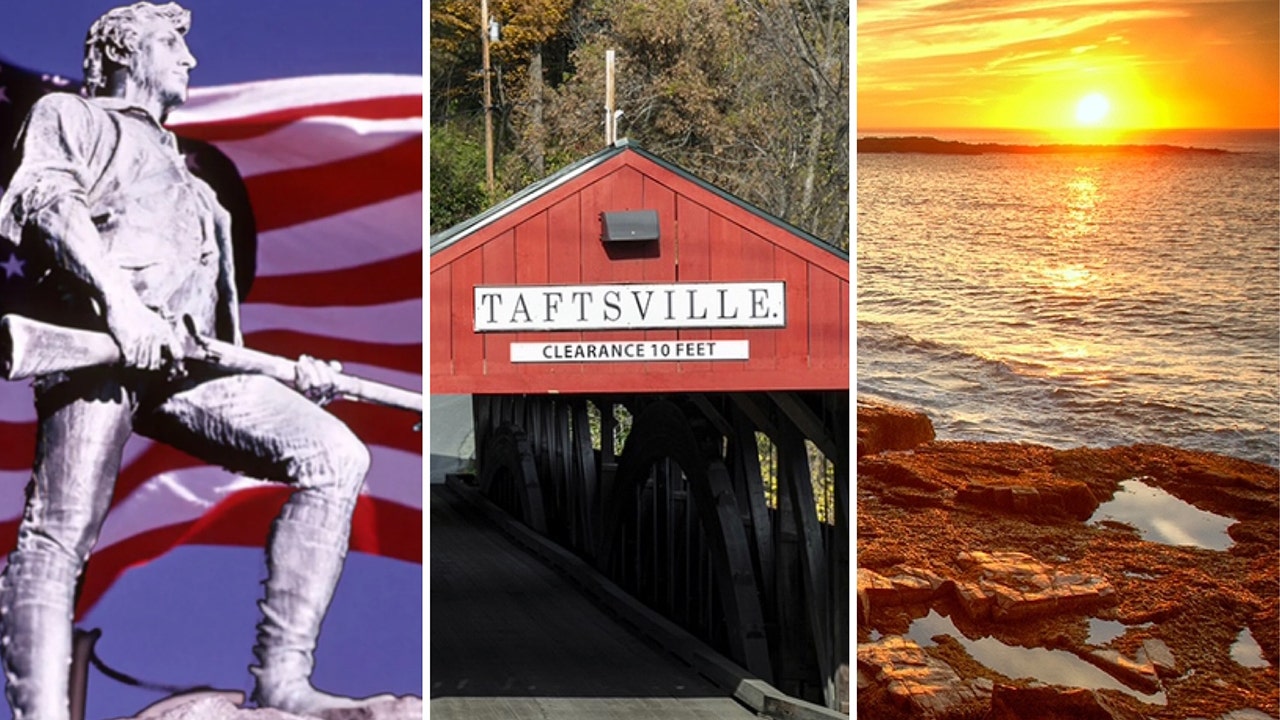
New England packs a lot of U.S.A. in a little corner of America.
Its six states combined would rank only 18th among the 50 states.
Visitors driving north up Interstate 95 can leave New York – not New England – and drive clear across Connecticut and Rhode Island, north through Massachusetts, zip through coastal New Hampshire and arrive in southern Maine in just five hours.
That’s five states, 10% of all of them, in a single afternoon, missing only the sixth New England state — beautiful, rural Vermont.
KANSAS CITY HOME TO AMERICA’S BEST BARBECUE, CHEFS CLAIM ‘OUR VARIETY MAKES US UNIQUE’
There’s plenty to see along the way. Among the options are plenty of coastlines, the sites that gave birth to the United States and spectacular autumn foliage.
Here is one must-see site in these six New England states.
Connecticut – Mystic Seaport
Mystic Connecticut USA. The small railroad station at Mystic is shown with a decorated hay cart. (Education Images/Universal Images Group via Getty Images)
America’s largest maritime museum brings the nation’s sailing heritage to life today with its historic New England oceanfront village, exhibits, period arts and crafts, and vessels such as the Charles W. Morgan, the world’s last remaining wooden whale ship.
The area is still essential to the nation’s maritime heritage today.
The U.S. Navy submarine fleet is headquartered a few miles west in Groton, where visitors can explore the USS Nautilus and Submarine Force Museum.
Maine – Acadia National Park
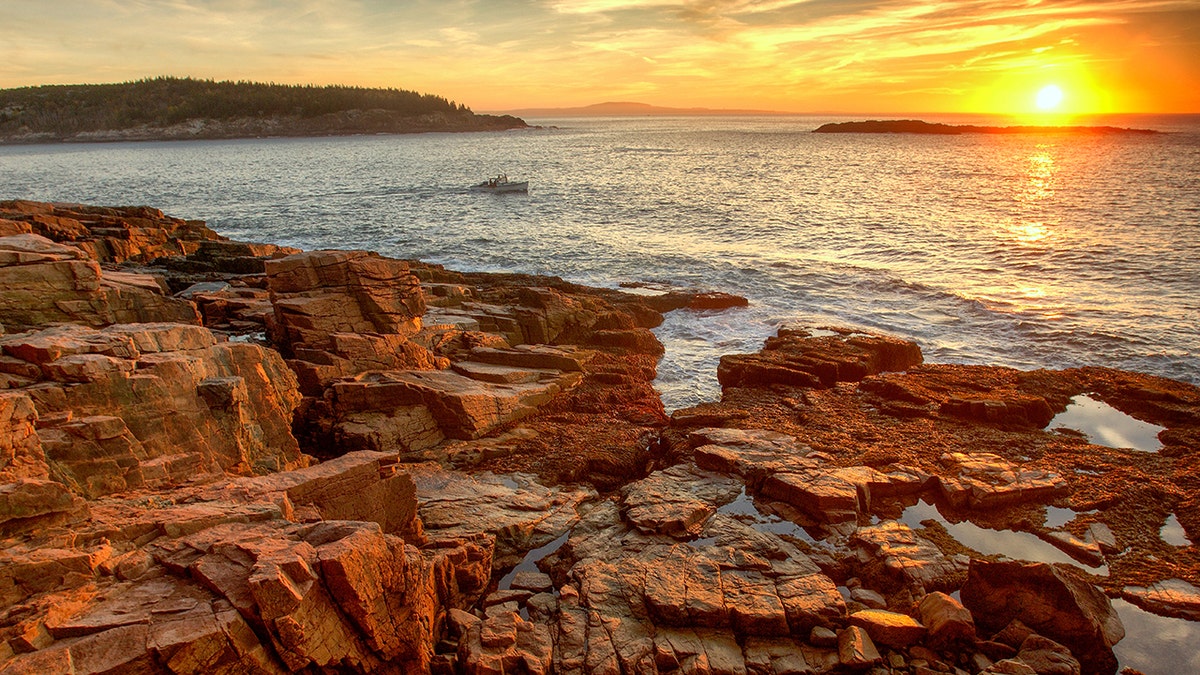
Sunrise over Acadia National Park, Mount Desert Island, Maine. (Dukas/Universal Images Group via Getty Images)
The majestic park offers the most spectacular example of New England’s famously rugged rocky coast.
The Atlantic Ocean gives way to a granite shoreline, then sprawling pinewood forests and stunning terrain highlighted by Cadillac Mountain, the highest peak on the eastern seaboard.
FALL LEAF-PEEPING NEW ENGLAND TRAVEL HAS AMERICANS EYEING 6 STATES AND DATES
Visitors also experience Maine’s unique downeast culture — complete with its own curious accent.
It offers a postcard landscape of lobster boats anchored in snug coves, quaint coastal villages of artists and boat builders, with havens for rock climbers, snowmobilers and ice fishermen.
Massachusetts – Minute Man National Historical Park
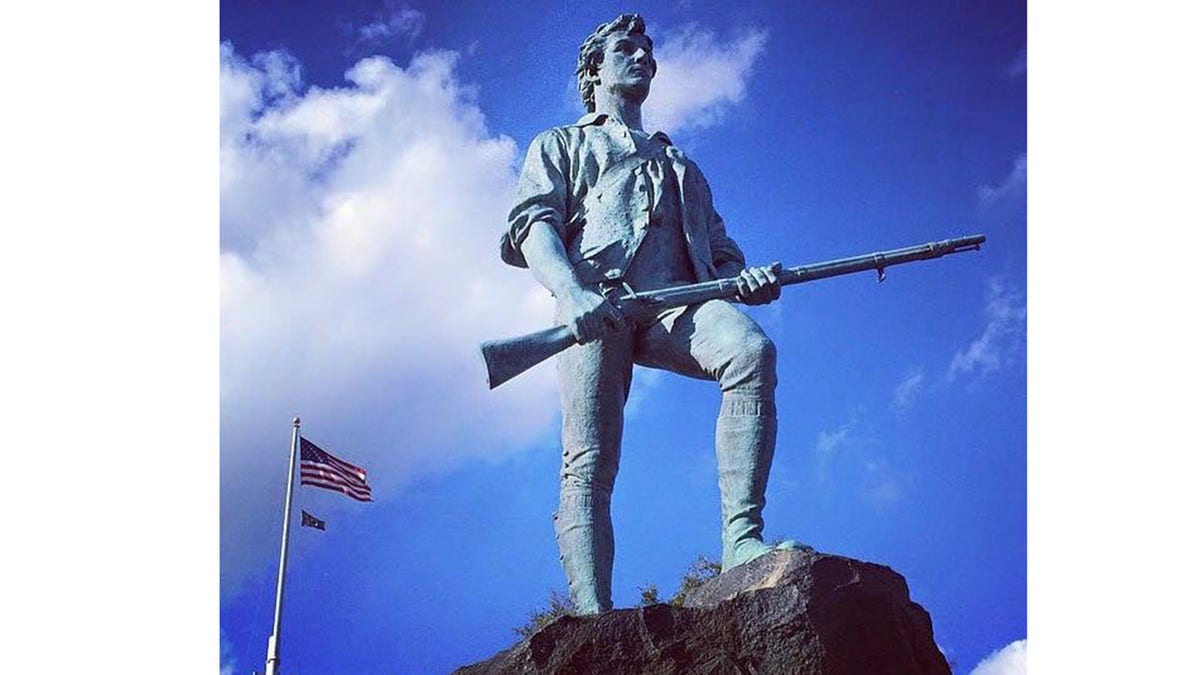
The Minuteman Statue in Lexington, Mass. is meant to depict Captain John Parker, who led the outnumbered Lexington militia against the British regulars on April 19, 1775. The ensuing skirmish, the “shot heard ’round the world,” ignited the American Revolution. (Kerry J. Byrne/Fox News Digital)
This serpentine park meandering through woodlands and town squares west of Boston tells the heroic tale of April 19, 1775, when 80 armed American civilians stood their ground on Lexington Common as 700 British troops, agents of the most powerful king in the world, pressed down upon them.
The Redcoats were looking to capture local munitions and rebel leaders Sam Adams and John Hancock. “Throw down ye arms,” a British officer commanded.
The outnumbered Americans did not surrender their arms. The “shot heard ‘round the world” rang out — and the American Revolution had begun.
MEET THE AMERICAN WHO LED 77 MINUTEMEN AGAINST 700 REDCOATS AT BATTLE OF LEXINGTON: CAPTAIN JOHN PARKER
The Lexington minutemen were quickly overrun, eight of them killed; but they had bought time as the call to arms spread across the countryside. The growing American force at Concord a few miles west greeted the British and turned them back.
Soon, thousands of colonists chased the Redcoats all the way back to Boston, decimating their ranks along the way. “What a Glorious Morning for America,” the street signs of Lexington still read today.
New Hampshire – Mount Washington
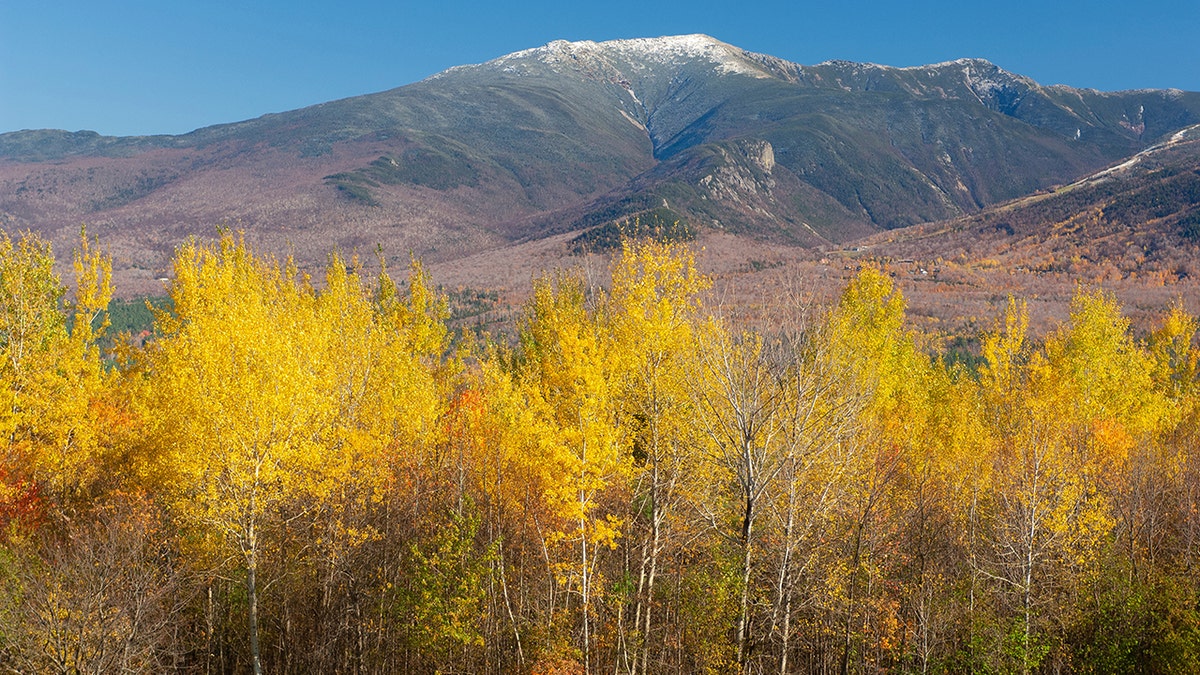
Mount Washington in New Hampshire in autumn. (Dukas/Universal Images Group via Getty Images)
The centerpiece of the Presidential Range of the White Mountains is nothing less than the tallest peak in the northeast (6,288 feet). More famously, Mount Washington habitually witnesses the globe’s most severe weather — due to its elevation and its location at the convergence of several major storm patterns.
Mount Washington’s brutal wind and cold is proclaimed locally as a testament to the hearty nature of “Live Free or Die” state residents. The summit held the record for highest wind speed ever recorded (231 mph) for several decades and reached a record low temperate of -50 degrees Fahrenheit in January 1885.
The Mount Washington Observatory recorded a wind chill of -103 degrees as recently as 2004.
The mountain today is a popular attraction for tourists, who ascend the top via hiking trail, precarious auto road or popular cog railway.
Rhode Island – Newport Mansions
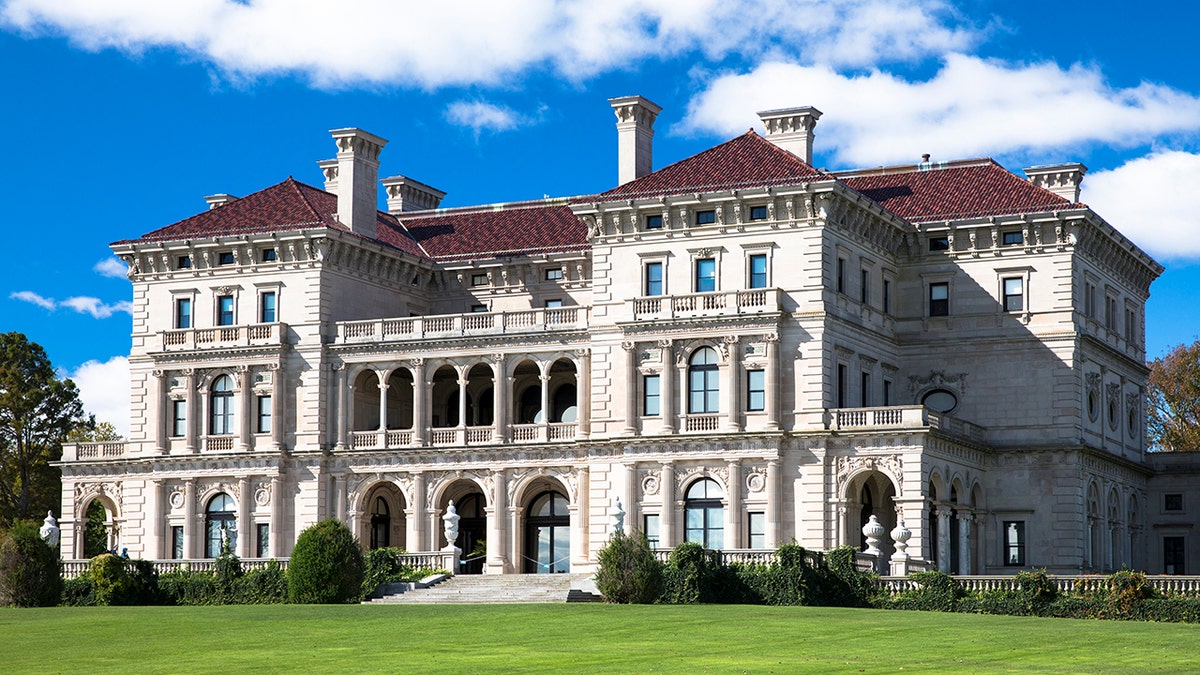
The Breakers, built in 1895 as a summer estate by the Vanderbilt family, one of the famous mansions in Newport, Rhode Island. (Tim Graham/Getty Images)
The wealth of the Gilded Age springs to life in Newport, where the nation’s titans of 19th-century industry built ostentatious summer homes on the cliffs where scenic Narragansett Bay meets the Atlantic Ocean.
The Breakers, owned by railroad tycoon Cornelius Vanderbilt II, is probably the most spectacular, built of limestone in the ornate style of an Italian palazzo. Newport’s legacy as a playground of wealthy lives on today around its charming and busy New England downtown waterfront.
The city is home to the International Tennis Hall of Fame and hosted the America’s Cup, the world’s premier sailing race, for decades.
Vermont – Lake Champlain
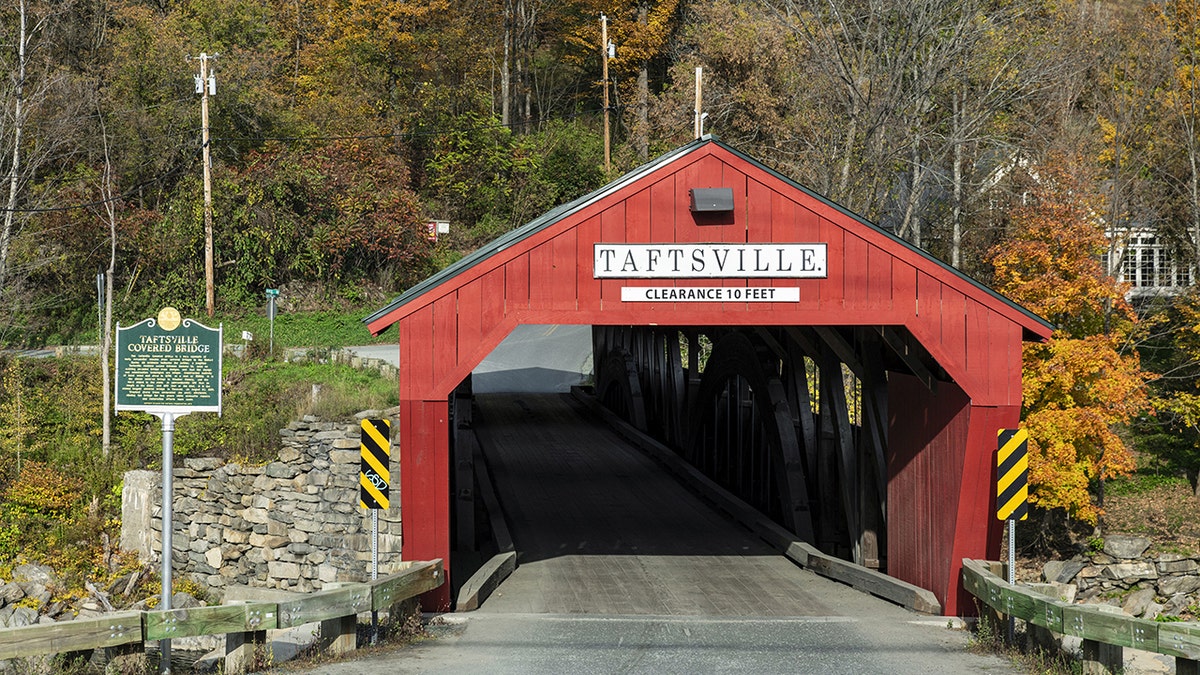
Taftsville covered bridge at Taftsville in Vermont. (John Greim/Loop Images/Universal Images Group via Getty Images)
The “Sixth Great Lake” sits on the border of New York and is best explored from the quintessential New England college town of Burlington.
It has loomed large in both Native and European American history.
Lake Champlain divided the Mohawks to the west and Abenaki to the east, while British and continental forces fought for control of the 107 mile-long lake throughout the American Revolution.
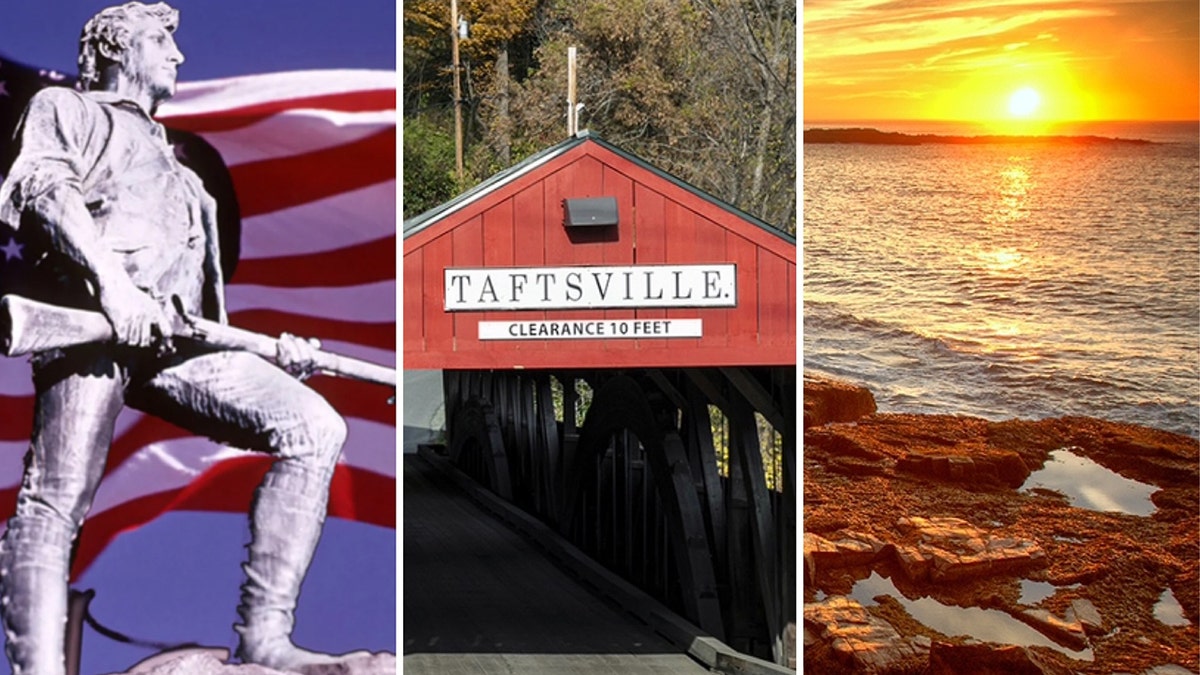
MInuteman statute, Lexington, Massachusetts’ covered bridge, Taftsville, Vermont; sunrise over Acadia National Park, Maine. (H. Armstrong Roberts/ClassicStock/Getty Images; John Greim/Loop Images/Universal Images Group via Getty Images; Dukas/Universal Images Group via Getty Images)
Lake Champlain today is a perfect place to enjoy the pristine wilderness and especially the autumn foliage of northern New England — or to search for Champy.
For more Lifestyle articles, visit www.foxnews.com/lifestyle
The mysterious Loch Ness monster-like creature was first known to the Abenaki, allegedly witnessed by French explorer Samuel de Champlain himself, and reported by dozens of other witnesses in the centuries since.
Read the full article from Here

Northeast
Transgender Congress member 'mystified' that GOP 'prioritizes' trans athlete bans in girls sports

Sarah McBride, the first openly transgender member of Congress, blasted Republicans for focusing on keeping transgender athletes out of girls and women’s sports.
Delaware, the state where McBride won election to serve as the representative of its at-large district, does not have laws restricting trans athletes from participating in sports that do not align with their gender at birth.
“I’ve had conversations with colleagues about many of the bills that are coming before us and certainly have heard from some colleagues who, like me, are mystified that this is a priority for a Republican conference that is entering a Republican trifecta, that this is an issue that they prioritize,” she told The Independent recently.
“And it defies understanding, except for the fact that it’s a pretty obvious part of a politics of misdirection and distraction.”
Rep.-elect Sarah McBride, D-Del., poses for a photo after joining other congressional freshmen of the 119th Congress for a group photograph on the steps of the House of Representatives at the U.S. Capitol Nov. 15, 2024, in Washington, D.C. (Andrew Harnik/Getty Images)
Sen. Tommy Tuberville, R-Ala., reintroduced a measure earlier this week to prevent biological male participation in women’s and girls sports in the Republican-led Senate. With the approval of leadership, it’s expected to get a floor vote.
The Protection of Women and Girls in Sports Act has been a years-long crusade for the Alabama Republican, who originally introduced it in 2023.
The measure would maintain that Title IX treats gender as “recognized based solely on a person’s reproductive biology and genetics at birth” and does not adjust it to apply to gender identity.
Twenty-eight states have limitations on trans athletes participating in sports that align with their gender identity.
Since McBride’s election, there has been a battle on Capitol Hill about whether McBride should be allowed to use women’s restrooms.
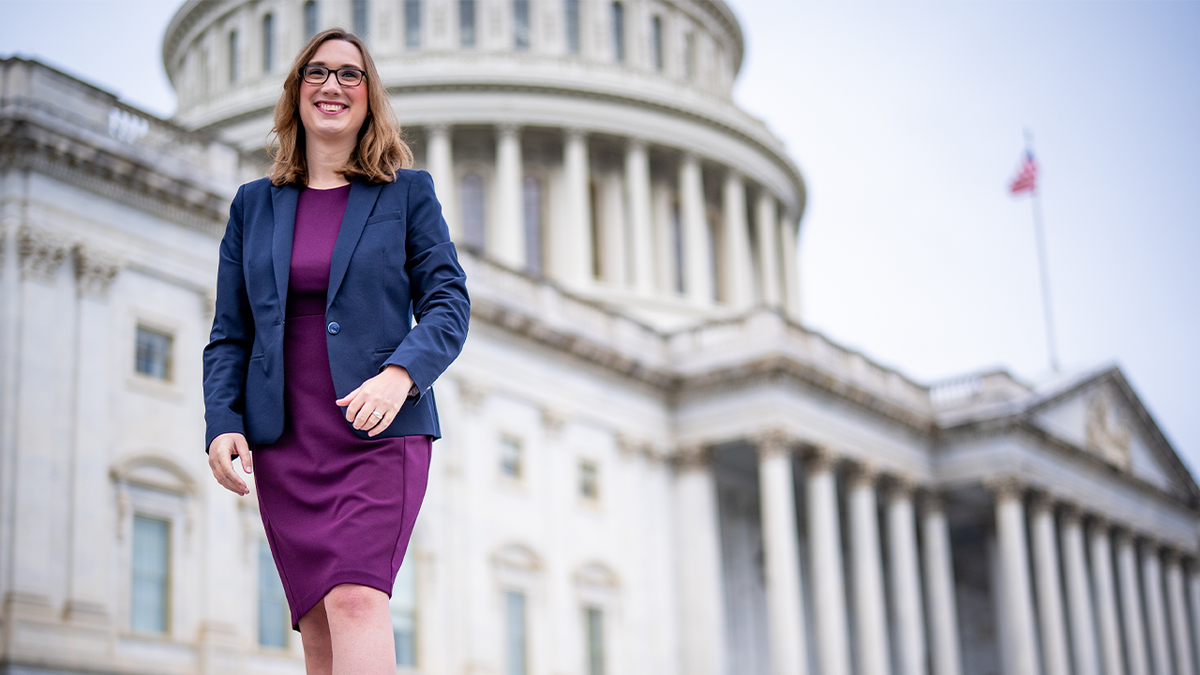
Rep.-elect Sarah McBride, D-Del., poses for a photo on the steps of the House of Representatives at the U.S. Capitol Nov. 15, 2024, in Washington, D.C. (Andrew Harnik/Getty Images)
Tuberville’s legislation would ban federal funding from going to athletic programs that allow biological men to participate in women’s and girls sports.
President-elect Trump has said he would “ban” transgender athletes born male from participating in girls and women’s sports.
President Biden recently dropped potential protections for transgender athletes.
“President Trump ran on the issue of saving women’s sports and won in a landslide,” Tuberville, a former college football coach, said in a statement to Fox News Digital. “Seventy percent of Americans agree — men don’t belong in women’s sports or locker rooms. I have said many times that I think Title IX is one of the best things to come out of Washington. But in the last few years, it has been destroyed.
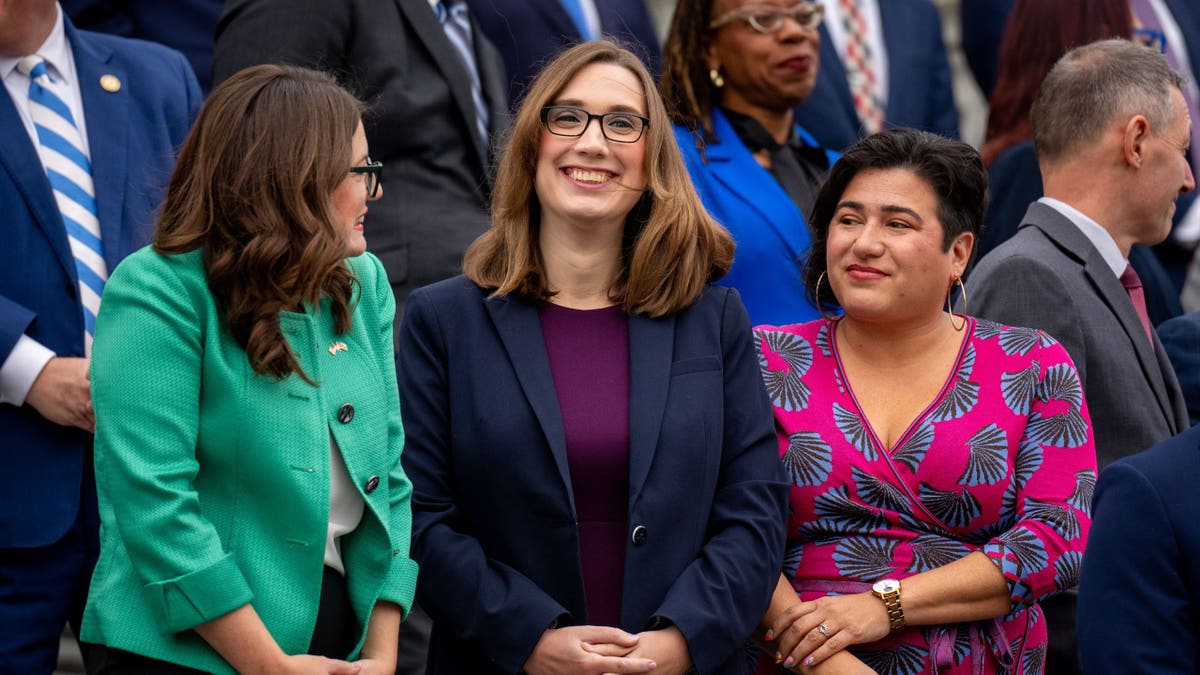
Reps.-elect Sarah Elfreth, D-Md.; Sarah McBride, D-Del.; and Emily Randall, D-Wash., speak as they and other congressional freshmen of the 119th Congress gather for a group photograph on the steps of the House of Representatives at the U.S. Capitol Nov. 15, 2024, in Washington, D.C. (Andrew Harnik/Getty Images)
“While I’m glad that the Biden administration ultimately rescinded the proposed rule, Congress has to ensure this never happens again. I am welcoming my first granddaughter this spring and won’t stop fighting until her rights to fairly compete are protected. I hope every one of my colleagues will join me in standing up for our daughters, nieces and granddaughters by voting for this critical bill.”
Fox News’ Julia Johnson contributed to this report.
Follow Fox News Digital’s sports coverage on X, and subscribe to the Fox News Sports Huddle newsletter.
Read the full article from Here
New York
As Trump Returns, Murphy Plans to Protect Abortion Access in New Jersey

As he prepares for his final year as governor of New Jersey, Philip D. Murphy on Tuesday proposed banning cellphones in schools and disclosed plans to blunt any additional limits on abortion access by the Trump administration.
Mr. Murphy also said he would work to address last year’s alarming 14 percent increase in roadway fatalities by overhauling the state’s 10 most dangerous intersections.
Mr. Murphy, a Democrat, began his seventh State of the State address in Trenton by acknowledging what he called “the elephant that is not in the room”: President-elect Donald J. Trump.
“I know there is some uncertainty and even concern about what this administration will bring,” the governor said, drawing the first round of applause from the standing-room-only crowd.
Mr. Murphy, who plans to attend Mr. Trump’s inauguration next week, said he “would never back away from partnering with the Trump administration” when doing so aligned with New Jersey’s priorities. But he vowed to fight Mr. Trump “if and when” those values are tested.
To that end, he said that New Jersey would stockpile a supply of mifepristone, one of two drugs used in medication abortions, in the event that Mr. Trump moved to limit its availability.
Aides to Mr. Murphy said New Jersey’s Department of Health had already begun gathering a six-month “strategic reserve” of medications, including mifepristone, which will be stored with abortion providers.
New Jersey law permits abortion throughout a pregnancy. But the governor also said that he would pursue legislation to end out-of-pocket costs for the procedure, reiterating a proposal he made last year.
As he outlined his priorities for his final year in office, Mr. Murphy said he would push for legislation to provide full pay to state workers on parental leave, make full-day kindergarten mandatory in the small number of towns that do not already offer it and permit 16- and 17-year-olds to vote in school board elections.
But perhaps the loudest and most sustained applause came when Mr. Murphy said he would direct school districts to adopt policies that ban cellphones in the state’s elementary, middle and high schools.
“Our children are inundated with screens,” Mr. Murphy said, adding that cellphone use had fueled a rise in cyberbullying and contributed to a mental health crisis among children.
“We will help establish phone-free schools,” he vowed.
New York’s governor, Kathy Hochul, said Monday that she planned to limit cellphone use in schools.
New York and New Jersey join a growing number of states, including Virginia, Ohio and Minnesota, that have moved to limit the use of the devices in schools. Los Angeles Unified became the largest school district in the United States to ban cellphones last year.
Mr. Murphy is prohibited by law from running for more than two consecutive terms, and November’s race to replace him is already in full swing.
Six prominent Democrats and four Republicans are competing for their party’s nomination to run for governor in the June primaries. The list of contenders includes the mayors of the state’s two largest cities, two members of Congress and a former Republican Assembly member who came within three percentage points of beating Mr. Murphy in 2021.
Indeed, the governor’s speech had a perfunctory air, and members of the audience at times appeared distracted; some repeatedly exited and re-entered the State Assembly chamber throughout the address.
The Republican leader of the State Senate, Anthony M. Bucco, called Mr. Murphy’s address a retread of costly, feel-good policy proposals.
“This state has become more and more and more unaffordable,” Mr. Bucco said.
“The days of spending outside of our means are coming to an end,” he added.
Still, the hourlong speech offered a window into major challenges facing New Jersey, including last year’s 14 percent increase in roadway fatalities.
Traffic fatalities nationwide have been declining. But last year in New Jersey, there were 691 traffic deaths, up from 606 the year before. Pedestrian fatalities soared by 32 percent.
The increase coincided with a drastic eight-month reduction in traffic enforcement by State Police troopers, who in July 2023 began writing far fewer tickets for speeding, drunken driving, cellphone use and other violations.
The reduced enforcement began a week after the state’s attorney general, Matthew J. Platkin, released a report critical of the performance of the State Police, New Jersey’s largest policing agency.
In August 2023, the first full month of the slowdown, troopers wrote 81 percent fewer tickets statewide, and crashes on the state’s two main highways immediately began to increase, according to records obtained by The New York Times through public records requests.
Mr. Platkin has appointed Preet Bharara, a prominent former federal prosecutor in Manhattan, to lead a criminal investigation of the slowdown.
Mr. Murphy is the only official in New Jersey with the power to replace the State Police superintendent, Col. Patrick Callahan, who led the department during the slowdown.
On Monday, when asked about the relationship between traffic fatalities and the reduced levels of enforcement, Mr. Murphy said, “If we’re not enforcing the laws on the books, that’s unacceptable.”
But he also worked to shift accountability for the slowdown away from himself and instead place full responsibility on Mr. Platkin and Colonel Callahan.
“It’s on their backs to get this into the right place,” Mr. Murphy said, adding that he had confidence in both men.
A spokesman for Colonel Callahan did not respond to a request for comment.
On Monday, Mr. Murphy signed a bill that created a commission dedicated to reducing the number of traffic fatalities in New Jersey to zero by 2040.
On Tuesday, he told lawmakers that he would “work with all of you to make New Jersey’s roads safer.”
He also announced plans to “overhaul” 10 of the state’s most dangerous intersections “to keep our families safe and to help prevent avoidable tragedies.”
Boston, MA
Boston City Councilor will introduce

BOSTON – It could cost you more to get a soda soon. The Boston City Council is proposing a tax on sugary drinks, saying the money on unhealthy beverages can be put to good use.
A benefit for public health?
“I’ve heard from a lot of residents in my district who are supportive of a tax on sugary beverages, but they want to make sure that these funds are used for public health,” said City Councilor Sharon Durkan, who is introducing the “Sugar Tax,” modeled on Philadelphia and Seattle. She said it’s a great way to introduce and fund health initiatives and slowly improve public health.
A study from Boston University found that cities that implemented a tax on sugary drinks saw a 33% decrease in sales.
“What it does is it creates an environment where we are discouraging the use of something that we know, over time, causes cancer, causes diet-related diseases, causes obesity and other diet-related illnesses,” she said.
Soda drinkers say no to “Sugar Tax”
Soda drinkers don’t see the benefit.
Delaney Doidge stopped by the store to get a mid-day pick-me-up on Tuesday.
“I wasn’t planning on getting anything, but we needed toilet paper, and I wanted a Diet Coke, so I got a Diet Coke,” she said, adding that a tax on sugary drinks is an overreach, forcing her to ask: What’s next?
“Then we’d have to tax everything else that brings people enjoyment,” Doidge said. “If somebody wants a sweet treat, they deserve it, no tax.”
Store owners said they’re worried about how an additional tax would impact their businesses.
Durkan plans to bring the tax idea before the City Council on Wednesday to start the conversation about what rates would look like.
Massachusetts considered a similar tax in 2017.
-

 Health1 week ago
Health1 week agoOzempic ‘microdosing’ is the new weight-loss trend: Should you try it?
-
/cdn.vox-cdn.com/uploads/chorus_asset/file/25822586/STK169_ZUCKERBERG_MAGA_STKS491_CVIRGINIA_A.jpg)
/cdn.vox-cdn.com/uploads/chorus_asset/file/25822586/STK169_ZUCKERBERG_MAGA_STKS491_CVIRGINIA_A.jpg) Technology6 days ago
Technology6 days agoMeta is highlighting a splintering global approach to online speech
-

 Science3 days ago
Science3 days agoMetro will offer free rides in L.A. through Sunday due to fires
-
/cdn.vox-cdn.com/uploads/chorus_asset/file/25821992/videoframe_720397.png)
/cdn.vox-cdn.com/uploads/chorus_asset/file/25821992/videoframe_720397.png) Technology7 days ago
Technology7 days agoLas Vegas police release ChatGPT logs from the suspect in the Cybertruck explosion
-

 Movie Reviews1 week ago
Movie Reviews1 week ago‘How to Make Millions Before Grandma Dies’ Review: Thai Oscar Entry Is a Disarmingly Sentimental Tear-Jerker
-

 Health1 week ago
Health1 week agoMichael J. Fox honored with Presidential Medal of Freedom for Parkinson’s research efforts
-

 Movie Reviews1 week ago
Movie Reviews1 week agoMovie Review: Millennials try to buy-in or opt-out of the “American Meltdown”
-

 News7 days ago
News7 days agoPhotos: Pacific Palisades Wildfire Engulfs Homes in an L.A. Neighborhood















